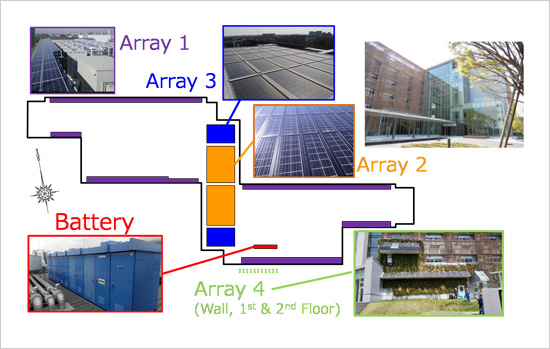Publication of Big Data on a Photovoltaic Microgrid Equipped with Rechargeable Batteries
—Actual Operational Data May Assist Design of Advanced Energy Management Systems—
2019.02.19
National Institute for Materials Science
NIMS has released big data collected during the actual operation of a photovoltaic microgrid system equipped with rechargeable batteries and published a description of the data in a journal focusing on scientifically valuable datasets. This big data may provide a foundation for the design of advanced energy management systems, such as systems capable of compensating for the continuous fluctuation of renewable energy sources through optimum utilization of rechargeable batteries, thereby stably satisfying energy demand.
Abstract
- NIMS has released big data collected during the actual operation of a photovoltaic microgrid system equipped with rechargeable batteries and published a description of the data in a journal focusing on scientifically valuable datasets. This big data may provide a foundation for the design of advanced energy management systems, such as systems capable of compensating for the continuous fluctuation of renewable energy sources through optimum utilization of rechargeable batteries, thereby stably satisfying energy demand.
- Microgrids are a core technology that enables the development of renewable energy-based power supply systems. Microgrid systems into which renewable energy is integrated can serve as valuable decentralized power supply sources in the event of severe disasters and other emergency situations. For example, during the extensive blackout caused by the September 2018 Hokkaido Eastern Iburi Earthquake, the electricity supply was initially restored using rechargeable batteries followed by wind power generation systems. Full-scale operation of microgrids requires advanced energy management systems capable of coping with continuously changing electricity demands and outputs. Designing these systems necessitates analysis of data collected during the actual operation of comparable systems. However, publically available data of this type had been limited to data on energy demand collected from residential and office buildings overseas. Operational microgrid data should include the characteristics of both renewable energy generation and rechargeable battery operation in relation to energy demand for buildings supplied by microgrids; this data had not been published anywhere in the world.
- A NIMS research team collected a variety of operational data, including the rate at which electricity was generated, for more than three years from an actually operating photovoltaic microgrid system equipped with rechargeable batteries. The team then cleansed the data and has made the clean data available to the public through figshare (a cloud-based data sharing system) and imeji (the NIMS data repository). The big data released on the operation of the microgrid system consists of 104,544,000 data points recorded each second in reference to 12 parameters, including the amount of photovoltaic power generated, the amount of battery charge/discharge and the amount of electricity supplied by the power company.
- The amount of electricity generated using solar energy and other renewable energy sources fluctuates continuously. In order to integrate renewable energy-derived electricity into power grids, the output fluctuation rate must be regulated to within 1% of rated capacity per minute. Determining the conditions necessary to achieve this requires data collected at intervals shorter than three seconds. The big data we have released was collected for multiple years at an interval of one second, allowing such analysis including seasonal and yearly changes. Accordingly, it is expected to serve as fundamental data for the design of technologies capable of regulating frequency fluctuations within microgrid systems. In future studies, we will analyze the big data, develop advanced microgrid system operation methods, design optimum system structures and expedite practical use of microgrid systems by carrying out data-driven analyses.
- This project was carried out by a research team consisting of Michihisa Koyama (Unit Director, Center for Green Research on Energy and Environmental Materials, NIMS), Karina Vink (Postdoctoral Researcher, NIMS) and Eriko Ankyu (Postdoctoral Researcher, NIMS). This work was supported by the MEXT Program for Integrated Materials Development (Director-General of GREEN: Kohei Uosaki).
- This research was published in Scientific Data, a journal for descriptions of scientifically valuable datasets and research, at 2:30 pm on February 19, 2019, GMT (11:30 pm on that date, Japan Time).

Figure. Schematic locations of the roof-mounted solar arrays as well as pictures of battery and side-wall solar array.
Related files
- Center for Green Research on Energy and Environmental Materials
- GREEN
Contacts
(Regarding this research)
-
Michihisa Koyama
Center for Green Research on Energy and Environmental Materials,
National Institute for Materials Science
Tel: +81-29-860-4757
E-Mail: KOYAMA.Michihisa=nims.go.jp
(Please change "=" to "@")
(For general inquiries)
-
Public Relations Office
National Institute for Materials Sciences
Tel: +81-29-859-2026
Fax: +81-29-859-2017
E-Mail: pressrelease=ml.nims.go.jp
(Please change "=" to "@")
Same Keywords
-
Estimation of Technology Level Required for Low-Cost Renewable Hydrogen Production
(solar,battery)
2018.12.13
-
Development of a Model Capable of Predicting the Cycle Lives of High-Energy-Density Lithium-Metal Batteries
(battery)
2024.07.24
-
Development of a Technology Enabling the Fabrication of Rechargeable Magnesium Batteries in a Dry Air Atmosphere
(battery)
2023.05.16
